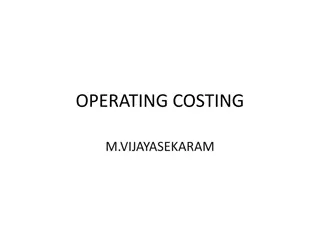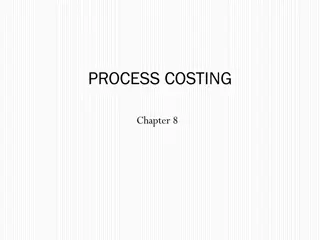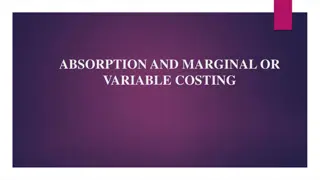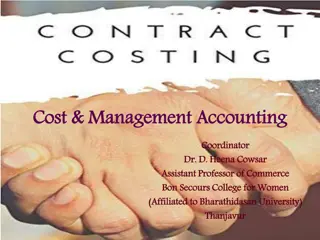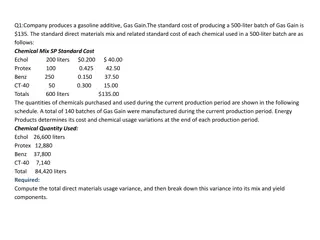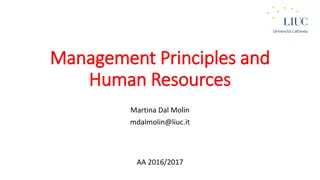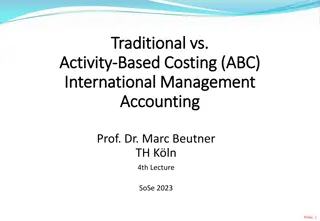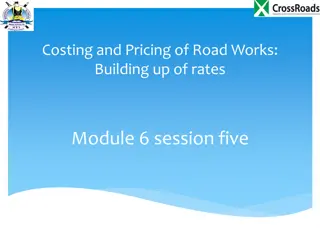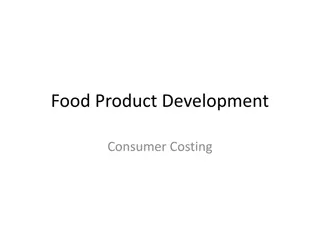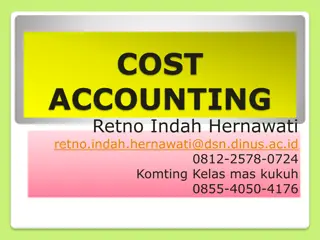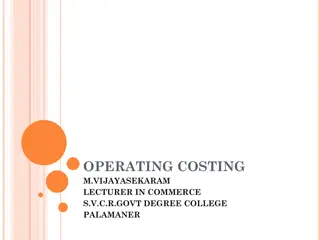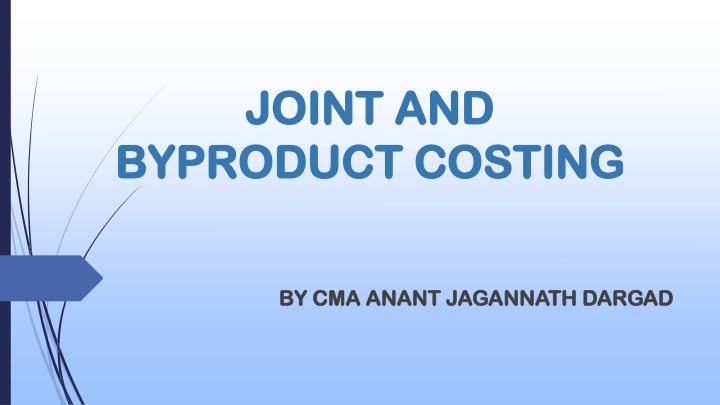
Treatment of Joint and By-Product Costing in Cost Accounting
In cost accounting, joint products and by-products play a significant role in the treatment of costs. Joint products are products derived from the same operation requiring further processing, while by-products are incidental products with relatively insignificant values compared to the main products. Understanding the definitions, distinctions, and allocation of costs for joint and by-products is crucial in cost analysis and decision-making processes.
Download Presentation

Please find below an Image/Link to download the presentation.
The content on the website is provided AS IS for your information and personal use only. It may not be sold, licensed, or shared on other websites without obtaining consent from the author. If you encounter any issues during the download, it is possible that the publisher has removed the file from their server.
You are allowed to download the files provided on this website for personal or commercial use, subject to the condition that they are used lawfully. All files are the property of their respective owners.
The content on the website is provided AS IS for your information and personal use only. It may not be sold, licensed, or shared on other websites without obtaining consent from the author.
E N D
Presentation Transcript
JOINT AND JOINT AND BYPRODUCT COSTING BYPRODUCT COSTING BY CMA ANANT JAGANNATH DARGAD BY CMA ANANT JAGANNATH DARGAD
OVERVIEW Joint Products & By- Products Treatment of By-Product Cost in Cost Accounting Meaning of Joint Products and By-Products Apportionment of Joint Costs
DEFINATIONS DEFINATIONS Joint Products - Joint products represent two or more products separated in the course of the same processing operation usually requiring further processing, each product being in such proportion that no single product can be designated as a major product . By-Products - These are defined as products recovered from material discarded in a main process i.e. product which is recovered incidentally from the material used in the manufacture of main or desired products, such a by-product having either a net realisable value or a usable value which is relatively insignificant in comparison with the saleable value of the main or desired products. By-product may be further processed to increase their realisable value
Petroleum Gas Gasoline (Petrol) Kerosene Crude Oil Molasses is produced as a Byproduct in the process of Sugar Manufacturing Diesel Industrial Fuel Oil Lubricating Oil, Paraffin Wax and Asphalt Petroleum Petroleum Refining Refining Processes Processes
Co Co- -Products Products Co-Products Joint products and co-products are used synonymously, but a distinction is there. . Co-products are two or more products which are contemporary but do not emerge necessarily from the same material in the same process. For instance Timber boards made from different trees are co-products. wheat and gram produced in two separate farms with separate processing of cultivation are co- products.
Split of Point Split of Point Split of Point Split of Point this is a point in a production process where joint this is a point in a production process where joint products emerging from the process gets separately identifiable. products emerging from the process gets separately identifiable. Split of Point has its importance in the joint product costing as joint Split of Point has its importance in the joint product costing as joint cost incurred up to this point only and needs to be borne jointly by cost incurred up to this point only and needs to be borne jointly by the products emerging from the common process. the products emerging from the common process. Any cost incurred after Split of Point is a product specific cost and to Any cost incurred after Split of Point is a product specific cost and to be borne by the product concerned. be borne by the product concerned.
APPORTIONMENT APPORTIONMENT OF JOINT COST TO OF JOINT COST TO JOINT PRODUCTS JOINT PRODUCTS Why Necessary ?? As the relations between materials, processes and joint products are As the relations between materials, processes and joint products are complex and unobservable, there is no way to determine the cost of complex and unobservable, there is no way to determine the cost of the different production factors used in the processes for the the different production factors used in the processes for the production of each of the joint products. Therefore, the costs production of each of the joint products. Therefore, the costs incurred in the manufacture of each of the joint products cannot be incurred in the manufacture of each of the joint products cannot be correctly identified. correctly identified. It can only be apportioned to the joint products by using some It can only be apportioned to the joint products by using some rational methods rational methods
METHODS OF APPORTIONMENT OF JOINT COST TO JOINT PRODUCTS
Physical Unit Method Physical Unit Method This method is based on the assumption that the joint products are capable of being measured in the same units. Accordingly, joint costs here are apportioned on the basis of some physical base, such as weight, numbers etc In In situation situation where products products must must be In In case, case, the the same measurement, measurement, this where physical physical units be converted converted to same cannot cannot be this method method cannot units are to a a common common unit be converted converted to cannot be be applied are different, different, the unit of of measurement measurement. . to a a common common unit applied the joint joint unit of of
Example A coke manufacturing company produces the following products by using 5,000 tonnes of coal @ Rs 1,100 per tonne into a common process. Coke Tar Sulphate of ammonia Benzol 3,500 tonnes 1,200 tonnes 52 tonnes 48 tonnes
Net Net Realizable Realizable Value at Split Point Method Point Method Value at Split- -off off To To arrive arrive at following following are products products at at the the sales are deducted deducted from at final final stage stage i i. .e e. . after sales value value at from the after processing processing: : at the the split the sales sales value split- -off value of off point, point, of joint joint Directly Directly attributable expenses expenses like like freight, Post Post split split- - off attributable Selling freight, royalty, off processing processing cost Selling and royalty, commission, commission, etc cost. . and distribution distribution etc. .
Example An entity incurs a joint cost of Rs 64,500 in producing two products A (200 units) and B (200 units) and earns a sales revenue of Rs 86,000 by selling @ Rs 170 per unit of product A and product B @ Rs 260 per unit. Further processing costs for products A and B are Rs 4,000 and Rs 32,000 respectively the Joint cost can be apportioned to products A and B as follows:
Using Technical Using Technical Estimates Estimates This method uses technical estimates to apportion the joint costs over the joint products. This method is used when the result obtained by the above methods does not match with the resources consumed by joint products or the realisable value of the joint products are not readily available.
Market value at the point of Market value at the point of separation separation It is a useful method when the It is a useful method when the realisable split split- -off (point of separation) is known and where further processing off (point of separation) is known and where further processing costs are incurred disproportionately costs are incurred disproportionately. . To determine the apportionment of joint costs over joint products, a factor known as multiplying factor is determined realisable value of joint products at value of joint products at Multipy in factor : Joint Cost Total Sales Revenue X 100
Example An entity incurs a joint cost of Rs 64,500 in producing two products A (200 units) and B (200 units) and earns a sales revenue of Rs 86,000 by selling @ Rs 170 per unit of product A and product B @ Rs 260 per unit. The multiplying factor in this case is obtained by dividing the total joint cost by total sales revenue and finally multiplying the figure so obtained by 100. The multiplying factor based on the data can be computed as follows: Multiplying Factor: Rs 64,500 100 = 75% Rs.86,000 Joint cost apportioned over product A = Sales revenue of product A 75% = Rs 34,000 75% = Rs 25,500 Joint cost apportioned over product B = Sales revenue of product B 75% = Rs 52,000 75% = Rs 39,000
Market value after further processing Market value after further processing The basis of apportionment of joint cost is the total sales value of finished products and involves the same principle as discussed above. The use of this method is unfair where further The use of this method is unfair where further processing costs after the point of separation are processing costs after the point of separation are disproportionate or when all the joint products are disproportionate or when all the joint products are not subjected to further processing. not subjected to further processing.
Example Example
Average Unit Cost Method Average Unit Cost Method Under this method, total process cost (upto the point of separation) is divided by total units of joint products produced. On division average cost per unit of production is obtained. Average unit cost = Total process cost (upto the point of separation) product produced. Total units of joint
Example FIND OUT the cost of joint products A, B and C using average unit cost method from the following data: Pre-separation Joint Cost Rs 60,000 Production data: Products Units A 500 B 200 C 300
Average cost per unit = Total joint costs = Rs 60,000 = Rs 60 Units produced 1,000 units
Methods of apportionment of Joint Cost to Byproduct
Comparative price Reuse basis
Treatment Of By-Product Cost In Cost- Accounting
CAS-19 COST ACCOUNTING STANDARD ON JOINT COSTS The Cost statement shall disclose the basis of allocation of Joint costs to individual products and the value assigned to the By-Products The Cost statement shall also disclose: The disclosure should be made only where material, significant & quantifiable. Disclosures shall be made in the body of Cost Statements or as a foot note or as a separate schedule. Any change in the cost accounting principles and methods applied for the measurement and assignment of the Joint costs and the value assigned to by-product during the period covered by the cost statement which has a material effect on the Joint/ By-Products shall be disclosed. Where the effect of such change is not ascertainable wholly or partly the fact shall be indicated.



